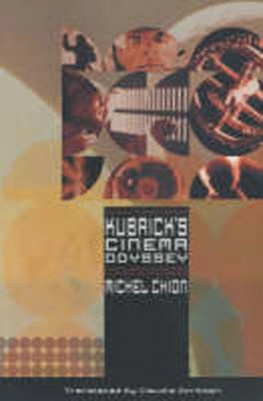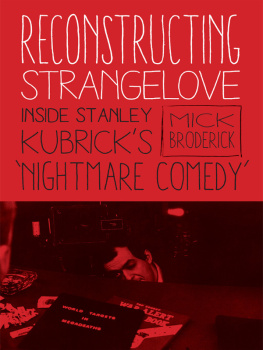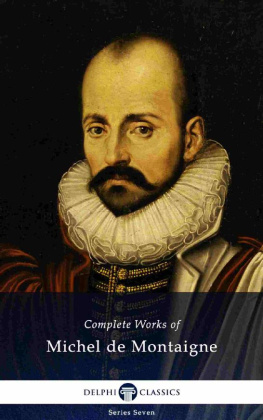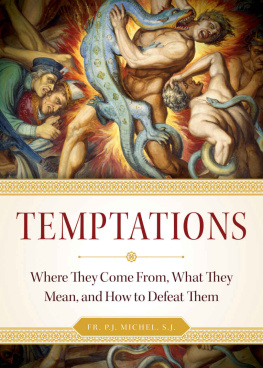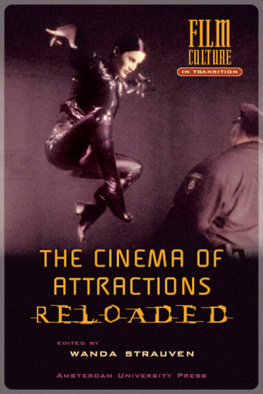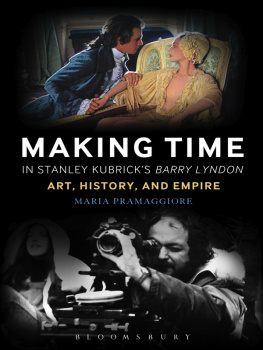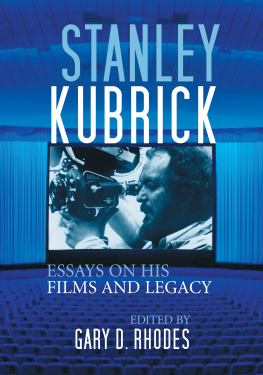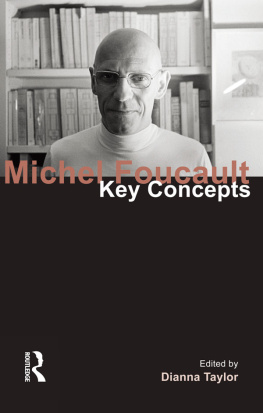Michel Chion - Kubricks Cinema Odyssey
Here you can read online Michel Chion - Kubricks Cinema Odyssey full text of the book (entire story) in english for free. Download pdf and epub, get meaning, cover and reviews about this ebook. year: 1999, publisher: Bloomsbury Publishing, genre: Non-fiction. Description of the work, (preface) as well as reviews are available. Best literature library LitArk.com created for fans of good reading and offers a wide selection of genres:
Romance novel
Science fiction
Adventure
Detective
Science
History
Home and family
Prose
Art
Politics
Computer
Non-fiction
Religion
Business
Children
Humor
Choose a favorite category and find really read worthwhile books. Enjoy immersion in the world of imagination, feel the emotions of the characters or learn something new for yourself, make an fascinating discovery.
- Book:Kubricks Cinema Odyssey
- Author:
- Publisher:Bloomsbury Publishing
- Genre:
- Year:1999
- Rating:4 / 5
- Favourites:Add to favourites
- Your mark:
- 80
- 1
- 2
- 3
- 4
- 5
Kubricks Cinema Odyssey: summary, description and annotation
We offer to read an annotation, description, summary or preface (depends on what the author of the book "Kubricks Cinema Odyssey" wrote himself). If you haven't found the necessary information about the book — write in the comments, we will try to find it.
Kubricks Cinema Odyssey — read online for free the complete book (whole text) full work
Below is the text of the book, divided by pages. System saving the place of the last page read, allows you to conveniently read the book "Kubricks Cinema Odyssey" online for free, without having to search again every time where you left off. Put a bookmark, and you can go to the page where you finished reading at any time.
Font size:
Interval:
Bookmark:

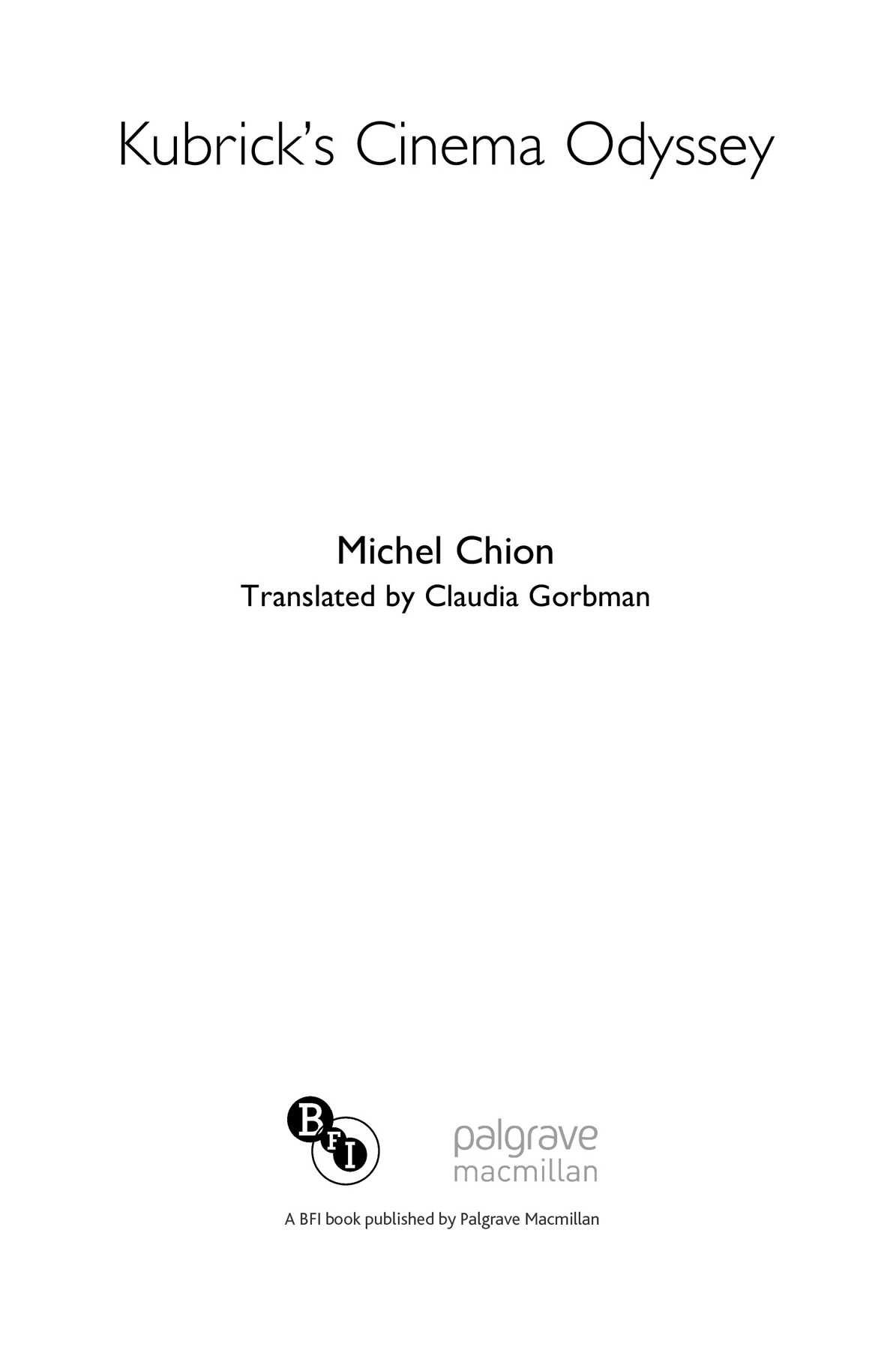
First published in 2001 by the
British Film Institute
21 Stephen Street, London W1P 2LN
The British Film Institute promotes greater understanding of, and access to, film and moving image culture in the UK.
Copyright Michel Chion 1999
Translation Claudia Gorbman 2001
Reprinted 2011
Cover design: Mark Swan
British Library Cataloguing-in-Publication Data
A catalogue record for this book is available from the British Library
ISBN 0 85170 839 0/978 0 85170 839 3 (pbk)
ISBN 0 85170 840 4/978 0 85170 840 9 (hbk)
ISBN 978-1-83871-665-3 (ePDF)
ISBN 978-1-83871-664-6 (eISBN)
Contents
The year 2001 rekindles our interest in a legendary work and a cinematic masterpiece in its own right. Stanley Kubricks 2001: A Space Odyssey has been symbolic in several respects since its release in 1968. Not only did it set a new course for science-fiction cinema; it also merged the two streams of big, popular films and experiments in pure cinema. In its sparse though essential dialogue, and in the way it foregrounds elements of film form itself sound, light, movement, editing 2001 is the father of all event movies, whose screenings have the aura of a religious rite. It draws on the sonic and visual experimentation of the early sound era as well as the 60s modernity (Antonioni, Tati) from which it springs. In aspiring towards non-verbal, universal experience, it embodies the dream of absolute cinema. Finally, it is among its directors most personal and daring films, a work that speaks to us in an extraordinarily strong way about the human condition.
Along with Jacques Tatis Playtime another futuristic montage released in the same year 2001 represents one of the rare efforts made during the 60s by a great director to wrench widescreen and stereo sound away from the inevitable territory of the blockbuster-of-the-thousand-extras, and to offer instead a slow, allusive, contemplative work. It produced myths for our time (the bone metamorphosing into a spacecraft over a four-million-year ellipsis; the Strauss waltz accompanying images of outer space; the death of the computer) that have enriched movie history and world culture.
To be sure, 2001: A Space Odyssey did not instantaneously spring forth as a classic. Its complex genesis illustrates the vicissitudes of the creative process, and the roles of chance, hesitation and determination.
2001 is a particularly fascinating film in that Kubrick exceeded the limits of his own perfectionism in making it, perhaps even more than in his other works. Intentional factors, when combined with the imponderables, doubts, technical problems and last-minute decisions and changes of mind, gave it dimensions it might otherwise not have had. Its creator thus could not measure the effects of many of his choices (especially his negative choices, when he cut sequences already shot, or eliminated narrative elements), and it was a sign of his genius that he could allow his work to slip from his control, so that, rather than being merely the execution of a blueprint, it could attain the status of an impersonal masterwork.
A book of a thousand pages could not begin to do justice to all the dimensions of 2001, one of the most widely discussed of all movies. I hope merely to open as many doors onto it as possible.
This book is multi-faceted, owing to my own desire to propose to readers a text on multiple levels and in complementary parts. The historical sections bring together and organise for the first time information and perspectives from many sources, including some that may be new to English-speaking readers. The more analytical and theoretical sections complement and extend the overall concerns of my critical writing begun in the book The Voice in Cinema.
A final chapter is devoted to Eyes Wide Shut, a film that came out after I began writing. In my estimation, Eyes Wide Shut is both a codicil to Kubricks oeuvre and an answer to 2001.
My sincere thanks go to Michel Ciment, Bruno Follet and especially Michel Marie for their help in the evolution of this book.
M. C., 17 July 1999
Notes
We shall see how the notion of a non-verbal cinema can only be conceived dialectically.
La Voix au cinma (Paris: ditions de ltoile, 1982). English translation Claudia Gorbman (New York: Columbia University Press, 1999).
Arthur C. Clarkes The Sentinel
Shot in England where Kubrick lived, 2001 had had a long and complex gestation. Kubrick eventually removed an enormous amount of the screenplays original narrative scaffolding (a documentary prologue about aliens, a voice-over commentary, Alex Norths epic score), a scaffolding that at the outset was an integral part of the project, and without the support of which he doubtless could not have constructed this singular film.
It was also Kubricks intention to bring special effects and models to an unprecedented level of perfection and to depict weightlessness more convincingly than ever in other words, to create a world governed by new laws.
His previous film, Dr Strangelove, was a great popular success, and Kubrick was hailed by the New York Film Critics Circle as Best Director of 1964. At that time he was interested in the question of the existence of extraterrestrials, and began to think about collaborating with the English science-fiction writer Arthur C. Clarke, author of (among many other works) a 1948 short story entitled The Sentinel, which would provide a point of departure for 2001.
In this brief piece, whose action is set in 1996, a geologist exploring the moons surface discovers an object shaped like a pyramid. It has been there for a very long time and was clearly constructed by someone. Its purpose is unknown (a building? a shrine?). But the geologist makes another surprising discovery: this object was preserved from meteorite attacks and cosmic dust by a sort of invisible hemispheric wall; stones thrown against it bounce off, proving that it is still being protected by active forces and is not the product of some defunct lunar civilisation. In a word, the object comes from elsewhere.
It takes twenty years of work to break through its invisible shield, whereupon closer examination indicates that a highly evolved technology from another solar system produced it. Whoever put it there, speculates the narrator, must have landed on the moon a very long time ago. They must have determined that the earth had the most suitable environment in the solar system for intelligent life, and then placed this monument on its satellite as an outpost sentinel, so that man would only see it if he attained a sufficiently high degree of evolution to be able to leave the cradle of his own planet and (the other necessary condition) if he has not already destroyed his species with the atomic energy he has unleashed. Now that the sentinel has been discovered and its protective shield forced open, it has stopped emitting its signal. Maybe those who left it there will show themselves, unless they are too old and in decline. The only thing to do from here on, says the narrator, is to wait; but I do not think we will have to wait for long.
Even if the screenplay by Kubrick and Clarke would end up being far more complex, bearing only a distant relationship to this short story, it is interesting to see the germ of several elements that remained in the film. There is, of course, the idea of an object left on the moon for centuries; there is also the secret relationship between the object and mankinds mastery of the nuclear menace. We know that in the film the object did not end up in the form of a four-sided pyramid. In addition, instead of the idea of an invisible shield, the screenplay presents a monolith that has been deliberately buried; this substitution gives the object the equivalent of a protective shield, and similarly poses a challenge to humans, and suggests intention (Show that you are strong and smart enough to find me). In the film, the earsplitting signal heard by the humans who start to photograph the object further suggests that the object is being protected.
Font size:
Interval:
Bookmark:
Similar books «Kubricks Cinema Odyssey»
Look at similar books to Kubricks Cinema Odyssey. We have selected literature similar in name and meaning in the hope of providing readers with more options to find new, interesting, not yet read works.
Discussion, reviews of the book Kubricks Cinema Odyssey and just readers' own opinions. Leave your comments, write what you think about the work, its meaning or the main characters. Specify what exactly you liked and what you didn't like, and why you think so.

